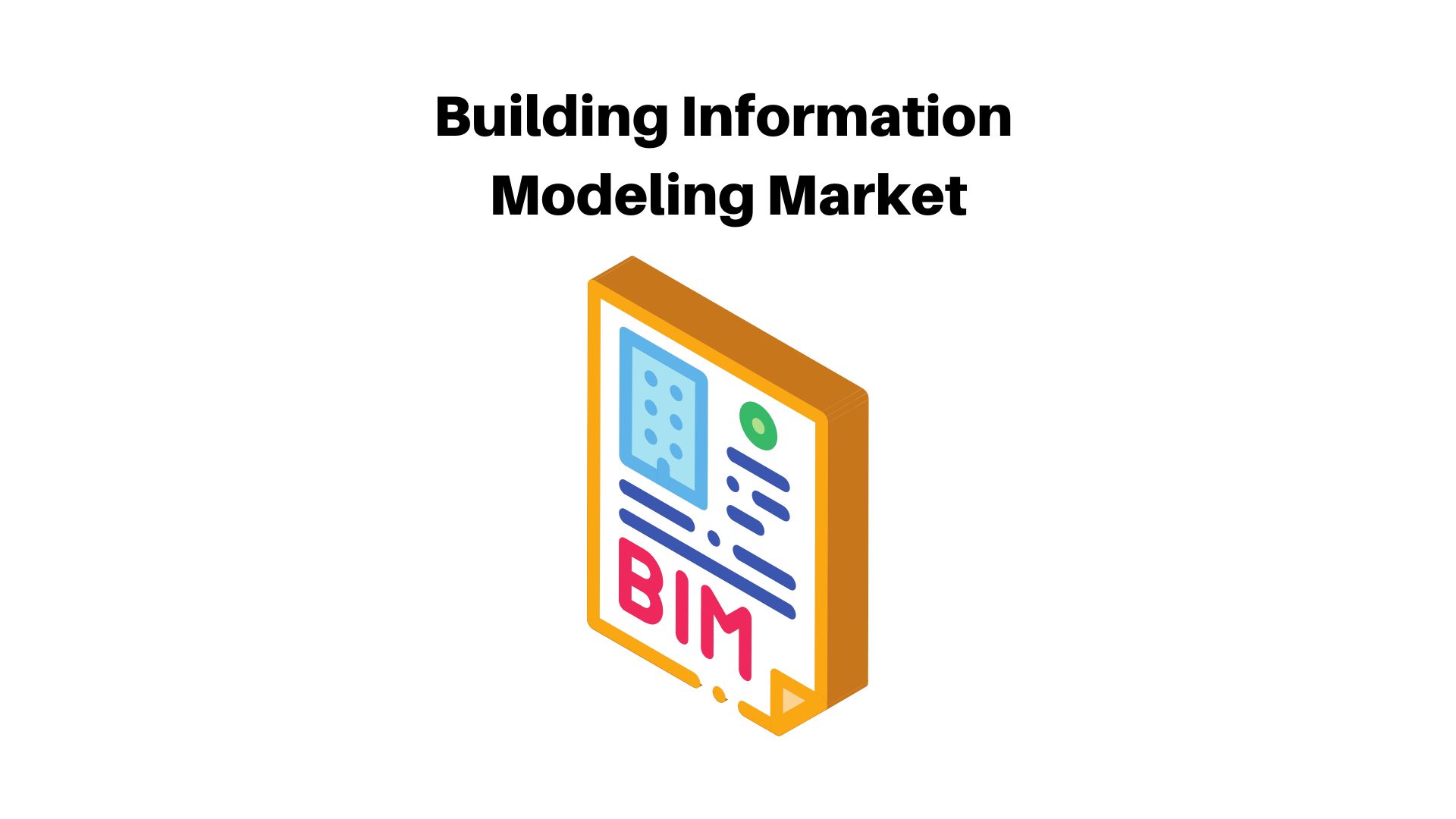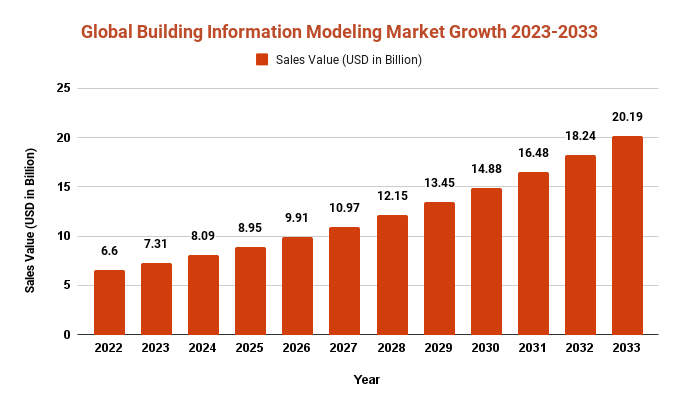Building Information Modeling Market Digital Process To Register USD 20.19 Bn Revenue By 2033

Page Contents
Market Overview
Published Via 11Press: Building Information Modeling (BIM) is a digital process that creates and manages virtual models of buildings and infrastructure projects. It utilizes software tools and technologies to capture, organize, and share information about a building or structure throughout its entire lifespan – from design to construction and upkeep. Building Information Modeling Market provides architects, engineers, contractors and other stakeholders with an efficient platform to collaborate on projects; streamlining design/construction phases while eliminating errors or conflicts while increasing efficiency and productivity levels.
The Global Building Information Modeling market represented USD 6.6 Bn in 2022 and will anticipate around USD 20.19 Bn by 2033 projected around CAGR of 10.7% amid forecast frame of 2023 to 2033.
The BIM model is a three-dimensional (3D) representation of the building or structure that contains all relevant physical and functional characteristics such as geometry, materials, lighting, ventilation, acoustics and energy performance. Furthermore, BIM allows for integration of different types of data such as cost estimates, schedules and maintenance requirements which can be used to optimize decision-making and project outcomes.
Key Takeaways
- BIM (Building Information Modeling) is a digital process that involves creating and maintaining virtual models of buildings and infrastructure projects.
- BIM (Building Information Modeling) is a collaborative platform that enables architects, engineers, contractors and other project stakeholders to work together more efficiently on a given project.
- BIM creates a three-dimensional (3D) representation of a building or structure, including all pertinent details regarding its physical and functional attributes.
- BIM allows the integration of various data and information, such as cost estimates, schedules, and maintenance needs – that can be utilized to enhance decision-making and optimize project outcomes.
- BIM simplifies the design and construction process, reduces errors and conflicts, and boosts efficiency and productivity.
- BIM can be applied throughout the entire life cycle of a building or structure, from design to construction and upkeep.
- BIM is an invaluable asset in building design and construction, as it facilitates collaboration, communication, and coordination among various stakeholders – ultimately improving project quality, efficiency, and sustainability.

Get Building Information Modeling Sample Market Report: https://marketresearch.biz/report/building-information-modeling-market/request-sample/
Regional Snapshot
- BIM adoption in North America has reached a critical mass, with the United States and Canada leading the charge. In the US, BIM is heavily used in construction projects and government mandated use for federal projects.
- Europe is a leader in BIM adoption, with countries such as the United Kingdom, Germany and Scandinavia leading the charge. The UK even mandated BIM for public projects – leading to widespread implementation across the nation.
- BIM adoption in Asia is on the rise, with China and Singapore leading the charge. China has launched a government-led initiative to promote BIM use within the construction industry, while Singapore requires BIM use for public projects.
- BIM adoption in the Middle East is on the rise, with United Arab Emirates (UAE) leading the charge. The UAE has mandated BIM use for public projects, which has seen its widespread implementation across the nation.
- BIM adoption in Africa is still at its early stages, with South Africa leading the charge. Unfortunately, lack of awareness and expertise have resulted in limited implementation across the continent.
Enquire with our industry specialist: https://marketresearch.biz/report/building-information-modeling-market/#inquiry
Drivers
- BIM simplifies the design and construction process, eliminates errors and conflicts, and increases efficiency and productivity. It allows different stakeholders to collaborate more efficiently, leading to fewer delays and rework.
- BIM can help to reduce costs by improving project planning and coordination, eliminating errors and rework, and optimizing material and resource use. Furthermore, it enables better decision-making through the integration of cost data and information.
- BIM can contribute to sustainability by allowing us to evaluate different design options and their environmental effects, as well as incorporate green technologies and materials into building design and construction processes.
- Many governments around the world have mandated BIM use for public projects, prompting its adoption in the construction industry. This is driven by a desire to enhance efficiency, productivity, and sustainability within this sector.
- Professional organizations and industry groups have also supported BIM adoption through initiatives and education programs, raising awareness and providing expertise about its use among various stakeholders.
- The development of new software tools and technologies have made BIM more approachable and user-friendly, leading to its adoption among small- and medium-sized firms that previously may not have had the resources for its use.
Restraints
Implementing BIM can be expensive, particularly for smaller firms that may not have the resources to invest in necessary software and hardware. Furthermore, training staff on its use may pose a further barrier to adoption. Some stakeholders in the construction industry may be resistant to change and prefer traditional methods of design and construction. This makes implementing BIM on projects difficult when there isn't buy-in from stakeholders. Furthermore, because BIM software and processes aren't standardized across industries, it becomes challenging for different parties to collaborate effectively; additionally, sharing BIM models across different projects or organizations becomes challenging as well.
BIM generates a vast amount of data that must be managed efficiently. This can prove challenging if there are no systems in place to guarantee its accuracy and consistency. Furthermore, using BIM may raise legal and contractual issues related to ownership of data and liability for errors and omissions, potentially creating obstacles to its adoption in countries without established legal frameworks.
Opportunities
- Enhanced Collaboration: BIM facilitates better collaboration among construction project stakeholders by allowing them to share data in real-time. This reduces delays and rework, improves communication, and boosts productivity levels.
- Enhancing Efficiency: BIM simplifies the design and construction process by eliminating errors, optimizing material use, and facilitating better decision-making. This results in improved efficiency, reduced costs, and quicker project completion times.
- Sustainability: Building Information Modeling (BIM) can promote sustainability in the construction industry by allowing for evaluation of different design options and their environmental impacts. Furthermore, it encourages the incorporation of green technologies and materials into building design and construction processes.
- Asset Management: BIM allows the creation of a digital model of the building that can be utilized throughout its lifespan for asset management and upkeep. This improves efficiency in maintenance activities while cutting down on overall building lifecycle cost.
- BIM for Construction Safety: BIM can be used to simulate construction processes and identify potential hazards and safety threats, ultimately helping improve safety on construction sites by reducing accidents and injuries.
- New Business Models: BIM can open the door to new business models and revenue streams, such as selling digital models or offering consulting and training services related to BIM.
Challenges
BIM requires specific skills and training to utilize effectively, which may present a challenge for some stakeholders in the construction industry, particularly smaller firms or those with limited resources. Furthermore, BIM generates large amounts of data which must be managed accurately and consistently; without systems in place to guarantee accuracy and consistency of that data, legal issues such as ownership of data and liability for errors/omissions could arise, potentially hindering its adoption abroad where legal frameworks are less well-established.
BIM software and processes are not uniform across the industry, making it challenging for different stakeholders to collaborate efficiently. Furthermore, sharing BIM models across projects and organizations can be challenging due to this inflexibility. Implementing BIM can be expensive, particularly for smaller companies who may not have the resources to invest in necessary software and hardware upgrades. Additionally, the cost of training staff in BIM usage can be an obstacle to adoption. Some stakeholders in the construction industry may be resistant to change and prefer traditional methods of design and construction; thus, implementing BIM on projects without buy-in from key stakeholders may prove challenging.
Market Segmentation
Global market segmentation, by component:
- Software
- Services
Global market segmentation, by deployment type:
- On-premise
- Cloud-based
Global market segmentation, by end users:
- Construction Manager
- General contractor
- Architect
- Engineer
- Owner
- Others
Global market segmentation, by vertical:
- Commercial
- Residential
- Educational
- Healthcare
- Entertainment
- Industrial
- Infrastructure
- Institutional
Key Players
- Pentagon Solutions Ltd
- Beck Technologies Ltd
- Dassault Systems SA
- Tekla Corporation
- Synchro Software Ltd
- Bentley Systems, Inc.
- Autodesk Inc
- Nemetschek AG
- AECOM Global, Inc.
- Intergraph Corporation
Report Scope
| Report Attribute | Details |
| Market size value in 2022 | USD 6.6 Bn |
| Revenue forecast by 2033 | USD 20.19 Bn |
| Growth Rate | CAGR Of 10.7% |
| Regions Covered | North America, Europe, Asia Pacific, Latin America, and Middle East & Africa, and Rest of the World |
| Historical Years | 2017-2022 |
| Base Year | 2022 |
| Estimated Year | 2023 |
| Short-Term Projection Year | 2028 |
| Long-Term Projected Year | 2033 |
Growing Demand => Request for Customization
Recent Developments
Cloud-based BIM solutions have become increasingly popular in recent years, enabling stakeholders to access models from anywhere and collaborate in real-time. This has improved efficiency, reduced costs, and made BIM more accessible for smaller firms and projects. BIM is becoming more widely utilized for facility management creating a digital model of the building that can be utilized throughout its lifespan for asset management and upkeep. This has improved building efficiency while cutting down on lifecycle cost of ownership. BIM is being integrated with virtual and augmented reality technologies, enabling stakeholders to view and experience the building design more vividly. This has improved communication, promoted collaboration, and promoted better decision-making.
Industry organizations and government entities are working to establish interoperability standards for BIM software and processes, enabling different stakeholders to collaborate more efficiently and share BIM models across projects and companies. BIM is being utilized to promote sustainability in the construction industry by evaluating different design options based on their environmental impact and integrating green technologies into building design and construction processes.
Key Questions
1. What is Building Information Modeling (BIM)?
BIM is an innovative digital process for designing, constructing and managing buildings and infrastructure. It involves creating a digital model of the building that can be utilized throughout its lifetime.
2. How does BIM improve collaboration in the construction industry?
Answer: BIM promotes collaboration in the industry by enabling different stakeholders to share data and information in real-time, which reduces delays, rework, enhances communication, and boosts productivity levels.
3. What are some of the challenges to adopting and implementing BIM?
Answer: Some issues related to adopting and implementing BIM include skills/training, data management, legal/contractual issues, interoperability costs and resistance to change.
4. How is BIM being utilized for facility management?
Answer: BIM is being employed in facility management by creating a digital model of the building that can be utilized throughout its lifecycle for asset management and upkeep, improving efficiency in maintenance operations. This enhances the productivity of building operations.
Contact us
Contact Person: Mr. Lawrence John
Marketresearch.Biz (Powered By Prudour Pvt. Ltd.)
Tel: +1 (347) 796-4335
Send Email: [email protected]
The team behind market.us, marketresearch.biz, market.biz and more. Our purpose is to keep our customers ahead of the game with regard to the markets. They may fluctuate up or down, but we will help you to stay ahead of the curve in these market fluctuations. Our consistent growth and ability to deliver in-depth analyses and market insight has engaged genuine market players. They have faith in us to offer the data and information they require to make balanced and decisive marketing decisions.